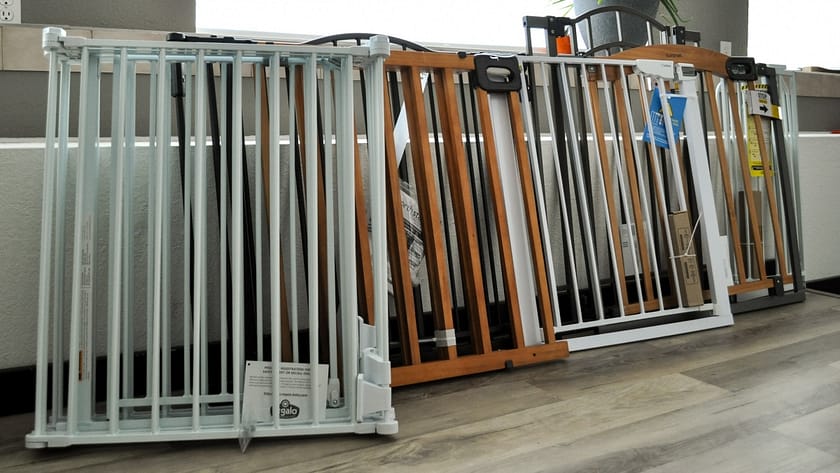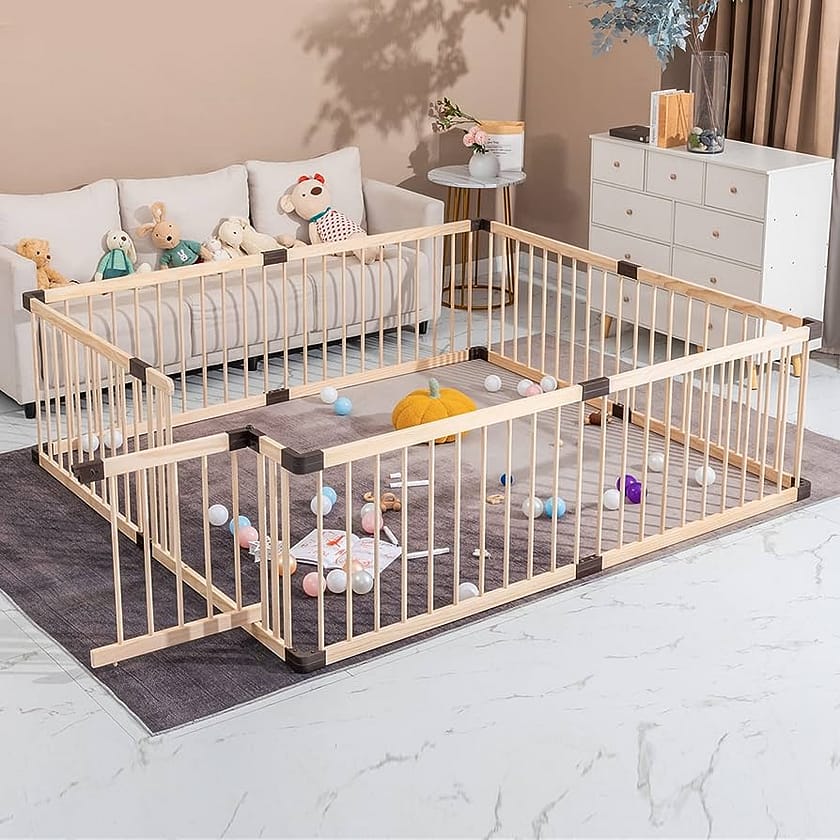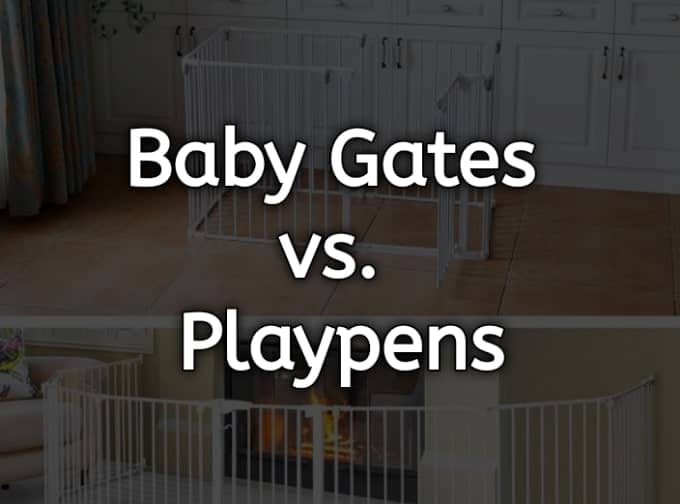Table of Contents
ToggleWhen it comes to ensuring the safety of your little explorer, the challenge is real and the stakes are high.
Baby gates and playpens both offer compelling solutions, but which one truly stands out as the superior option?
This is the ultimate showdown – “Baby Gates vs. Playpens.” As every child is unique, we understand that what works for one might not work for another.
Hence, we’ll delve into the benefits and limitations of each, helping you make the best choice for your child’s safety and your peace of mind.
Buckle up, as we navigate through the labyrinth of child safety products together!
Introduction: Baby gates vs. playpens.
Child safety is of paramount importance to every parent and caregiver. Children, especially toddlers, are innately curious and adventurous, often leading them into situations that may pose potential hazards.
Thankfully, innovatively designed safety measures such as baby gates and playpens have become popular parenting tools, serving as protective barriers that allow little adventurers to explore their surroundings safely.
Baby gates are effective tools for restricting access to areas like kitchens and staircases that might contain potential dangers.
On the other hand, playpens provide a confined, yet spacious area where children can play safely under minimal supervision. Both these measures play a crucial role in creating a child-friendly environment, thereby offering peace of mind to parents and caregivers.
Let’s deep dive into the comparison
The Case for Baby Gates:

Baby gates, also known as safety gates, are designed to create a safe barrier that prevents children from accessing areas that could be hazardous, such as kitchens, bathrooms, or staircases. They work by employing a locking mechanism that is easy for adults to operate but tough for little hands to figure out.
Benefits of Baby Gates:
- Defined Boundaries: Baby gates provide a clear boundary for your child, ensuring they stay within safe areas of the home.
- Versatile Use: They can be used in doorways, at the top or bottom of stairways, or even as room dividers.
- Easy Accessibility for Adults: The mechanisms used in most baby gates allow adults to easily open and close them, ensuring convenience.
- Peace of Mind: Knowing your child can’t access potentially dangerous parts of your home gives you peace of mind.
Potential Drawbacks of Baby Gates:
- Limited Space: Baby gates can limit the play area for your child, which might impact their mobility and exploration.
- Temporary Solution: As children grow and learn to open gates or climb over them, baby gates can become less effective.
- Installation Issues: Some baby gates require drilling into walls or staircases for installation, potentially damaging your home’s interior.
- Potential for Accidents: If not properly installed, a baby gate might fall down or be pushed over, leading to potential accidents.
Installation process:
Installing a baby gate is fairly straightforward. Most require minimal tools and can be secured using pressure or screws, depending on the model.
Pressure gates don’t require any drilling and are ideal for use with doorways or hallways, while screw-mounted gates are more suitable for staircases or other extra-wide openings. Whichever method you choose, make sure to follow the manufacturer’s instructions and install it securely.
If you want to read the full baby gates Installation process: Here is how to install baby gates safely
The Case for Playpens:

Playpens, also known as play yards, are enclosures that provide a safe and confined area for your child to play. They function by creating a spacious yet controlled environment for children, often equipped with engaging toys and soft surfaces to ensure safety while playing.
Benefits of Playpens:
- Controlled Environment: Playpens offer a well-controlled environment for your child to play and move around safely.
- Portable: Most playpens are foldable and easy to transport, making them an excellent choice for travel.
- Versatile: Some playpens come with adjustable panels that can be modified as per needs.
- Engaging: Many are equipped with toys and activities to keep your child entertained.
- Peace of Mind: Parents can safely engage in other tasks knowing their child is in a secure and fun space.
Potential Drawbacks of Playpens:
- Limited Exploration: Being confined to a playpen might limit a child’s exploration of their environment.
- Supervision Needed: While safer, children in playpens still require supervision to prevent accidents.
- Dependency: Overuse of a playpen might lead to dependency, limiting a child’s ability to play independently.
- Space Consuming: Playpens often take up more space compared to baby gates.
Installation process:
Playpens are easy to install. Most models come with an instruction manual that details the assembly process.
The required tools vary depending on the model, but typically all you need is a screwdriver and an adjustable wrench.
Make sure to follow the instructions carefully and assemble it securely.
Once installed, check for any loose screws or sharp edges that may pose a hazard.
Comparative Analysis: Baby Gates vs. Playpens.
When comparing baby gates and playpens in various circumstances, it’s useful to consider factors like portability, space requirement, and longevity of use.
Portability:
Baby gates, while not inherently portable, come in pressure-fit varieties that can be easily moved and adjusted.
However, they’re generally designed to be installed in a specific location. Playpens, on the other hand, are typically designed with portability in mind.
They can be folded down and transported, making them an ideal choice for those who travel frequently or require a mobile safe play area.
Space Requirement:
Baby gates take up minimal space as they’re used at entrances and exits of rooms or stairways, which doesn’t impede on the existing space.
Playpens, however, require a significant amount of room. While they provide a larger area for your child to play within, they also occupy more space in your home.
Longevity of Use:
Baby gates are a fantastic short to medium-term solution, providing safety for your child until they learn to open the gate or climb over it.
Playpens, on the other hand, can be used for a longer period as they’re harder for a child to escape from, but they also risk becoming a crutch that limits a child’s exploration of their environment.
Factors To Consider When Choosing Between Baby Gates and Playpens:
Deciding between a baby gate and a playpen can be a challenging task, as both offer unique advantages and pose different challenges.
It is essential to consider several factors to ensure the choice aligns with your child’s needs, your lifestyle, and your home’s design.
Child’s Age:
Depending on the child’s age, one safety measure may be more suitable than the other. For crawling infants or younger children, playpens can be a safer option as they provide a confined and controlled play area. As children grow older and more mobile, baby gates might become a better choice as they allow for increased freedom while still ensuring safety.
Home Environment:
The layout and size of your home also play a critical role. Larger homes with multiple hazardous areas might benefit from the use of baby gates. Conversely, for smaller homes or apartments, a playpen could be a space-efficient way to provide a safe play area.
Parents’ Lifestyle:
A busy parent who needs to multitask might find a playpen more useful, as it provides a secure space for the child during this time. Yet, for parents wishing to encourage independence and exploration, baby gates allow the child to roam freely within safe zones.
Travel Frequency:
For families who travel often, portability becomes a key consideration. Playpens are typically more portable than baby gates, which might be preferred by families who are frequently on the move.
Child’s Personality and Developmental Stage:
Consider your child’s personality and developmental stage. Children who are more adventurous may benefit from the freedom provided by baby gates, while a playpen might be better suited to children who are content with a more confined play area.
Safety:
Lastly, safety is paramount when considering any child protective measure. Baby gates should be sturdy, unclimbable, and have a secure locking mechanism. Playpens should be spacious, stable, and contain safe toys without sharp edges or small parts that could be a choking hazard.
For buying baby gates here is the full ultimate buying guide of baby gates.
Conclusion:
In conclusion, the choice between baby gates and playpens largely depends on individual circumstances and preferences. If your home environment has areas that could potentially be hazardous, or your child is older and needs more space to explore, a baby gate may be the better choice.
However, if you travel frequently, need a portable solution, or have a younger child who needs a controlled environment to play, playpens might be more suitable. It’s crucial to remember that irrespective of the option you choose, the safety and developmental needs of your child should always be the top priority.
Always ensure the product you select adheres to safety standards, and encourage a balance between safety and exploration in your child’s environment.


4 thoughts on “Baby Gates vs. Playpens: The Ultimate Showdown for Your Child’s Safety!”